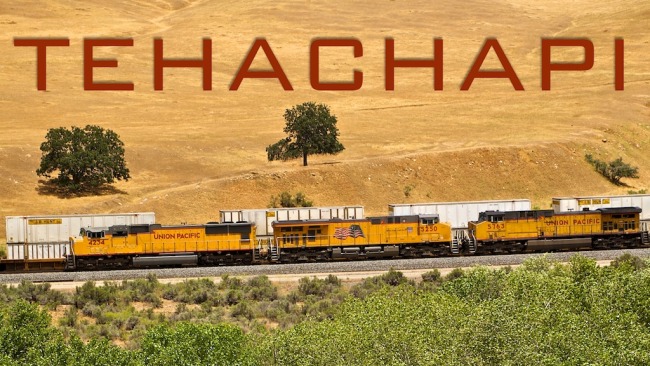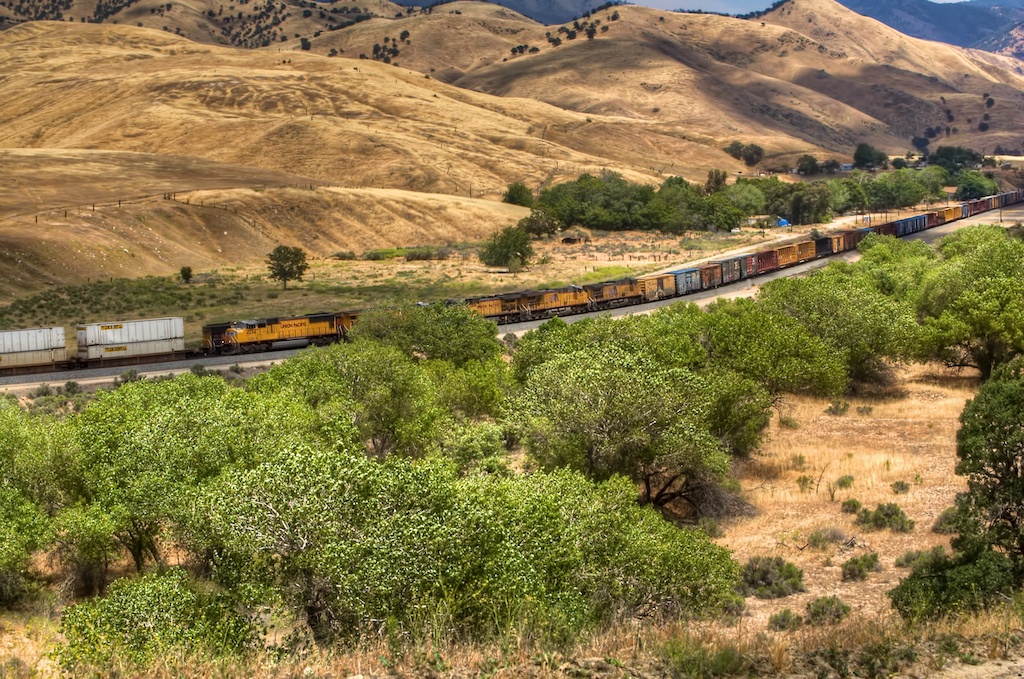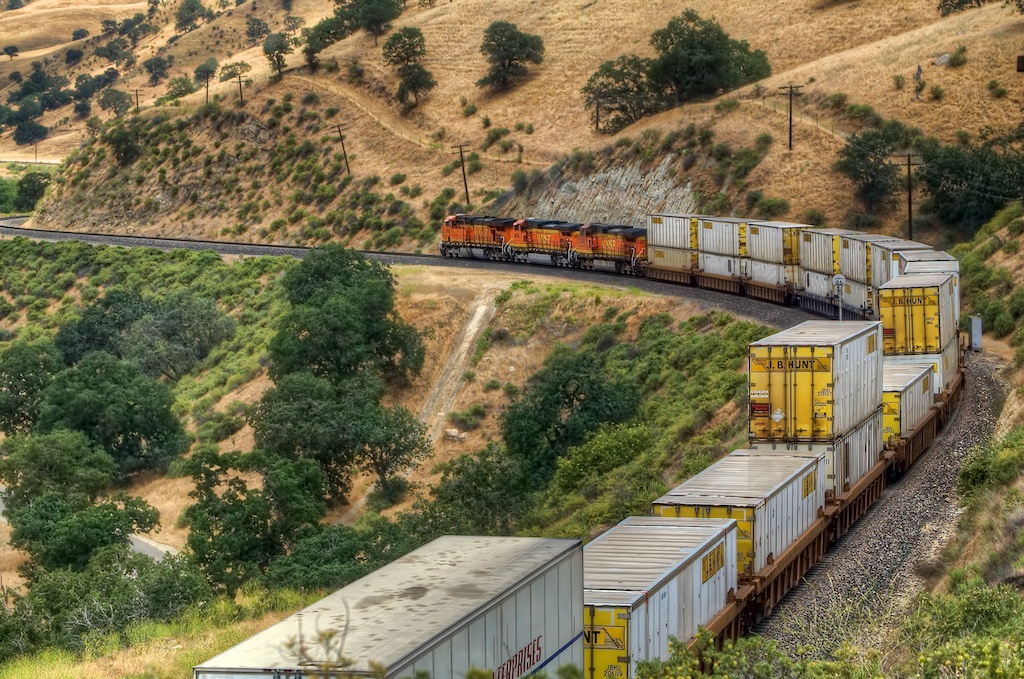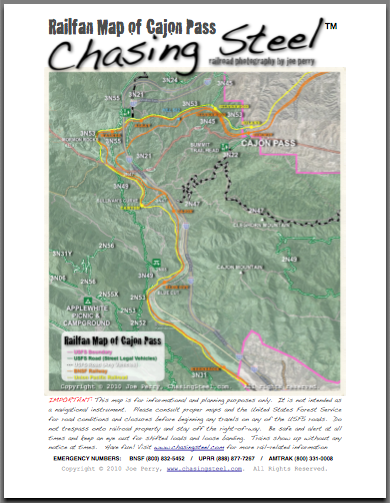Unreal, heck even surreal at times.
The last week has been one heck of a ride. I thought I went out, as I have done countless times in the past, to enjoy a chase and beautiful scenery with Deb but it became so much more. So what, it was a very long train, one the likes of I have never seen in thirty plus years of paying attention. Turns out it was a monster. But it was a monster in more than just size. It’s very existence changed me and my world in unimaginable ways. And yes, you are partly responsible for it too. Let me explain.
The “chase” itself was typical. The results, of course, weren’t. I had not posted any of my videos from previous trips onto the web for others to consume. This train was different and I know that there were people, fans and the general public alike, that would have liked to have been able to see it go by. (I think we all enjoy watching a train pass - more on than later.) So I intended, at the onset, to make sure to get a stationary video of the train passing. If you have read my previous posts then you know that I took that opportunity at Fingal, CA. I thought the video came out nice, despite the fact that I shot it in portrait mode instead of landscape, so I created an account on YouTube and posted the video so that fans and you might get to see the historic train.
It turns out that somehow the media got wind of the train and it’s monster length and that’s when things got crazy. I was first contacted by NBC News in Los Angeles, CA on Wednesday evening, January 13, 2010. They had seen the video on YouTube and wanted to run it on the 11PM news that night. Wow, that’s cool, I thought. Heck, who wouldn’t want their video shown on a major news network? Well, it turns out that railfans don’t. I didn’t know that at the time.
No sooner had I finished my phone call with the producer from NBC then I received an email from a reporter with the Los Angeles Times. (Do these guys work in the same office or have some secret Twitter arrangement?) He had seen the video and said it was the cleanest he saw and wanted to discuss it with me and perhaps link to it on the Times website. It was a crazy few minutes for sure.
At least the Times reporter took the time to talk to me about the experience and how I came to shoot the video. Clearly he wanted more than just a graphic to showcase HIS story. He was interested in MY story, however, I was caught up in the moment and didn’t realize what was about to happen.
NBC aired the video, as they said they wanted to do, however, their “story, ” in my opinion was not complete reporting. They opted to stress the wait time one would experience at a grade crossing and the politicians “concerns” over the train instead of the whole reason Union Pacific ran the test train or the significance of it. I was dismayed. I learned at the point that while I gave consent to NBC to use my video it was still their “story.” I wished I had been given an opportunity to provide input to the story.
I subsequently found out that the LA Times had also run an article on the train that very same day by the very same reporter. I became concerned. I read the article and felt that the Times reporter, which also mentioned the “political” concerns predominately, did at least give both sides to the story and apparently was willing to do more research, hence the email to me.
After the NBC news segment aired, the “noise” about the test train and my video elevated. You see, at this point I was being associated, since it was my video, with the viewpoint of the mass media on the subject and worth of the train. This was not my intent. In fact, my views are almost diametric to those of the “politicians” and some of the general public on the subject.
Here’s my stance:
- Railroads are VITAL to our nation’s economy and infrastructure.
- Railroads, and train crews specifically, DO NOT want to block crossings for any reasons, if at all possible.
- Emergency vehicles are being blocked every day in the US by even the smallest of trains today. (I bet that motorists block more fire engines and paramedics than trains do annually.)
- Stopping distance of train is determined by tonnage and speed of the train NOT the LENGTH of a train.
- Railroads have a vested interested in ensuring that the trains they move over their lines are safe. They do not want to create any situation that might cause a stoppage in movement of trains over their territories. That would be bad for business.
- The railroads are in the railroad business. Wouldn’t they know how and why to do this? If increasing capacity and/or reducing costs is an end result, isn’t that good for shareholders and aren’t they becoming more economically viable which is good for us all?
- People are in that much of a hurry that they can’t wait a few more minutes at a grade crossing so that they can get on to the freeways which are already gridlocked? The grade crossings are the joint responsibility of the municipalities in concert with railroad approval. The city has the right to build an over/underpass if they deem it necessary. The grade crossing complaints should go to the city councils not the railroads. The railroads have been around for a very, very, very long time in comparison to local streets and such. Also, don’t commuters already plan their routes based on traffic patterns and avoid certain stretches of surface streets or freeways at certain times of the day because of congestion already?
- There are concerns about the length of such a train when the crew has to walk the train to determine the extent of any issue should the need arise which caused the crew to stop the train. Obviously this would need to be addressed.
- While there are also concerns about the reduction in number of crew starts and I respect those concerns but I am in no position of offer an opinion. (Yep, that is perhaps a first!)
Based on the aforementioned points, it should be apparent why I had issues with the media propping up their stories with my footage. In the railfan circles I learned of another individual who had his video used, in the exact same manner, by a competing station here in Los Angeles all without his consent!
Now I began to worry about the end result of the LA Times inquiry about using my material and story in their next article about the “Monster Train.” Historically, us railfans have been portrayed in the mainstream media as complete morons who never got over the model trains we had as kids. I was determined to help shape this next article, if I could.
Fortunately, it turned out that the Times reporter, Rich Connell, was a good reporter and did his investigation and followed where it led him. Over the course of that week we had numerous emails and phone calls about the train and me. Perhaps my nudging helped but I sense that it propably was not entirely necessary in this case.
As a previous blog post indicates, I had no prior knowledge of Rich’s article “going to press.” It appeared online first and then in the print edition the next day. The only way I discovered it was the number of hits on my website went through the roof. My heart skipped a beat. (Which is not good due to a quadruple bypass and seven stents that adorn my life sustaining organ!) The article was published.
I read the article. Wow. Very good. Better than I thought it would be. It was about me and my “adventure.” Cool. It did mention the “other” items but in a realistic and tempered way. Outstanding! What a relief.
I have to take my hat off to you Rich. You wrote an insightful and good article. And it is not just me saying so. Read the comments on my Guestbook page or the posts on the main railroad board and you will see the “community” of railfans applaud the article. You have done us proud. Thank you Rich and thanks to Mark Boster for making me look half-way handsome!
So I learned this from it all:
- Understand the context in which your material will be presented.
- Politicians don’t know what they are talking about, mostly.
- There are good reporters out there who want to tell the WHOLE story and not just get ratings.
- My right side is my better side!
Overall I am grateful for it all because not only did I learn a lot about myself and the way the media functions, I also got to meet so many people like you. I received a lot emails and comments during the last few days and I am overwhelmed by the positive comments and response, in general, to my efforts to host chasingsteel.com. I appreciate the fact that you have taken your time to visit and read my rants, such at this. I am also humbled by the stories you all have shared with me and the great things you have said to inspire me.
OK, I realize there is one more thing I learned:
There are a lot of good and constructive folks in this world. Heck, even some of them are not railfans! Who knew? ;-)

 UP 4234 North 1 - UP 4234 (EMD SD70M), UP 5250 (GE ES44AC), UP 5763 (GE AC4400CTE), UP 5368 (GE ES44AC), and UP 5761 (GE AC4400CTE) in full dynamics to ease a heavy manifest train downgrade towards the horseshoe curve at Caliente, CA. Their battle with the Tehachapi Mountains will be over shortly as the grade will ease into the central valley of California.
UP 4234 North 1 - UP 4234 (EMD SD70M), UP 5250 (GE ES44AC), UP 5763 (GE AC4400CTE), UP 5368 (GE ES44AC), and UP 5761 (GE AC4400CTE) in full dynamics to ease a heavy manifest train downgrade towards the horseshoe curve at Caliente, CA. Their battle with the Tehachapi Mountains will be over shortly as the grade will ease into the central valley of California. UP 4234 North 2 - UP 4234 (EMD SD70M), UP 5250 (GE ES44AC), UP 5763 (GE AC4400CTE), UP 5368 (GE ES44AC), and UP 5761 (GE AC4400CTE) in full dynamics to ease a heavy manifest train downgrade towards the horseshoe curve at Caliente, CA. Their battle with the Tehachapi Mountains will be over shortly as the grade will ease into the central valley of California.
UP 4234 North 2 - UP 4234 (EMD SD70M), UP 5250 (GE ES44AC), UP 5763 (GE AC4400CTE), UP 5368 (GE ES44AC), and UP 5761 (GE AC4400CTE) in full dynamics to ease a heavy manifest train downgrade towards the horseshoe curve at Caliente, CA. Their battle with the Tehachapi Mountains will be over shortly as the grade will ease into the central valley of California. Horseshoe at Caliente - UP 4234 (EMD SD70M), UP 5250 (GE ES44AC), UP 5763 (GE AC4400CTE), UP 5368 (GE ES44AC), and UP 5761 (GE AC4400CTE) in full dynamics to ease a heavy manifest train downgrade and around the horseshoe curve at Caliente, CA.
Horseshoe at Caliente - UP 4234 (EMD SD70M), UP 5250 (GE ES44AC), UP 5763 (GE AC4400CTE), UP 5368 (GE ES44AC), and UP 5761 (GE AC4400CTE) in full dynamics to ease a heavy manifest train downgrade and around the horseshoe curve at Caliente, CA. Horseshoe at Caliente 2 - UP 4234 (EMD SD70M), UP 5250 (GE ES44AC), UP 5763 (GE AC4400CTE), UP 5368 (GE ES44AC), and UP 5761 (GE AC4400CTE) in full dynamics to ease a heavy manifest train downgrade and around the horseshoe curve at Caliente, CA.
Horseshoe at Caliente 2 - UP 4234 (EMD SD70M), UP 5250 (GE ES44AC), UP 5763 (GE AC4400CTE), UP 5368 (GE ES44AC), and UP 5761 (GE AC4400CTE) in full dynamics to ease a heavy manifest train downgrade and around the horseshoe curve at Caliente, CA. BNSF Z-Train and the Golden Hills of Tehachapi - A BNSF hot intermodal train is dwarfed by the golden grass-covered Tehachapi Mountains.
BNSF Z-Train and the Golden Hills of Tehachapi - A BNSF hot intermodal train is dwarfed by the golden grass-covered Tehachapi Mountains. BNSF 7740 West Descends Into Caliente - BNSF 7740 (GE ES44DC), BNSF 4674 (GE DASH 9-44CW), and BNSF 4792 (GE DASH 9-44CW) are holding back the tonnage of this westbound intermodal train as they descend the grade in the Tehachapi Pass into Caliente, CA.
BNSF 7740 West Descends Into Caliente - BNSF 7740 (GE ES44DC), BNSF 4674 (GE DASH 9-44CW), and BNSF 4792 (GE DASH 9-44CW) are holding back the tonnage of this westbound intermodal train as they descend the grade in the Tehachapi Pass into Caliente, CA. BNSF 7740 West Descends Into Caliente 2 - BNSF 7740 (GE ES44DC), BNSF 4674 (GE DASH 9-44CW), and BNSF 4792 (GE DASH 9-44CW) are holding back the tonnage of this westbound intermodal train as they descend the grade in the Tehachapi Pass into Caliente, CA.
BNSF 7740 West Descends Into Caliente 2 - BNSF 7740 (GE ES44DC), BNSF 4674 (GE DASH 9-44CW), and BNSF 4792 (GE DASH 9-44CW) are holding back the tonnage of this westbound intermodal train as they descend the grade in the Tehachapi Pass into Caliente, CA. BNSF 4866 East Climbs Out - BNSF 4866 (GE DASH 9-44CW), BNSF 4828 (GE DASH 9-44CW), BNSF 4768 (GE DASH 9-44CW), and BNSF 8739 (EMD GP60) climb the mountain shelf out of Caliente, CA heading towards Bealville with an eastbound intermodal train in tow.
BNSF 4866 East Climbs Out - BNSF 4866 (GE DASH 9-44CW), BNSF 4828 (GE DASH 9-44CW), BNSF 4768 (GE DASH 9-44CW), and BNSF 8739 (EMD GP60) climb the mountain shelf out of Caliente, CA heading towards Bealville with an eastbound intermodal train in tow. BNSF 4866 East Climbs Out 2 - BNSF 4866 (GE DASH 9-44CW), BNSF 4828 (GE DASH 9-44CW), BNSF 4768 (GE DASH 9-44CW), and BNSF 8739 (EMD GP60) climb the mountain shelf out of Caliente, CA heading towards Bealville with an eastbound intermodal train in tow.
BNSF 4866 East Climbs Out 2 - BNSF 4866 (GE DASH 9-44CW), BNSF 4828 (GE DASH 9-44CW), BNSF 4768 (GE DASH 9-44CW), and BNSF 8739 (EMD GP60) climb the mountain shelf out of Caliente, CA heading towards Bealville with an eastbound intermodal train in tow. BNSF,
BNSF,  Caliente,
Caliente,  HDR,
HDR,  Mojave Subdivision,
Mojave Subdivision,  Mountains,
Mountains,  Tehachapi,
Tehachapi,  Union Pacific CATEGORIES:
Union Pacific CATEGORIES:  General Photography,
General Photography,  Railroad Photography
Railroad Photography 


